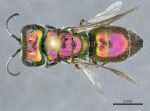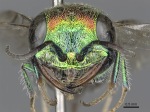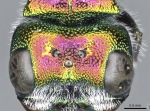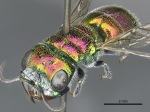The chrysidids are a large family of wasps, with around 3,000 species. Many are brilliantly metallic, with psychedelic patterns and intensely sculptured exoskeletons. Because they are all so strikingly beautiful, we’ve imaged quite a few, and rest assured – they’ll end up here! Future posts will have more stories about life-history and biology, but here’s a little overview for now. As always, click on images for full-size, and check out the gallery at the bottom.
Chrysidids are either parasitoids or cleptoparasites – baby chrysidids devour the egg or larval form of a host insect to grow, or they hatch within the nest of another insect, kill the young, and eat the food stores that the host mother provided for her own offspring. The family is most diverse in desert regions across the world.
Todays species, Chryis ehrengbergi (Dahlbom), belongs to the subfamily Chrysidinae. Known as the ‘cuckoo wasps,’ these cosmopolitan* little jewels make up the greatest number of species within the family. Some species are parasitoids, but most are cleptoparasites on wasps and solitary bees, and sometimes on lepidopterans (moths and butterflies). The egg is typically laid in the host nest before the parent and/or caretakers have finished provisioning it with food. The newly-hatched chrysidine larva kills the egg or host larva and nourishes itself on the provisions. This behavior is why they are called ‘cuckoos’, due to its similarity to the behavior of some cuckoo birds.
*found all around the world.
Members of this subfamily are fairly easy to recognize, even to the non-trained eye. Beside being strikingly metallic, the metasoma (apparent abdomen) is very concave on the bottom. This allows the wasp to roll up into a protective ball, sort of like a little armadillo. The big pits in their tough armor seem to be developed to deflect he stingers of angry wasps and bees, perhaps protective mothers who catch them depositing their nefarious young in their hard-earned nests.
Chrysis ehrenbergi has, among its many interesting features, a set of denticles – tooth like projections – along the end of its abdomen. These show up in a number of a chrysidine species. Only a few studies have examined what they are used for, but they seem to be helpful in holding onto the host cocoon, or the side of a host nest as the mother chews her way in to lay an egg.


- These are the anal teeth found in various chrysidines.
- The colors, patterns, and luster or many chrysidids are so vivid as to almost seem unnatural.
References (click for .pdf)
Goulet, H. & Huber, J., 1993. Hymenoptera of the world: an identification guide to families.
—————————————
The pictured specimen [BMNH(E)1015020] is the property of the Natural History Museum, London (BMNH).
All images and text contained in the above post are copyright © Z. Lieberman 2012. See bottom of page for usage guidelines.











